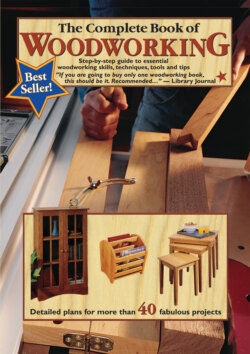Читать книгу Draw Manga - Tom Carpenter - Страница 24
На сайте Литреса книга снята с продажи.
Lumber Distortion & Defects
ОглавлениеOften lumber will not expand and contract uniformly, causing it to distort. Four types of distortion, caused largely by improper kiln drying, are cupping, crooking, bowing and winding. Cupping is where the two long edges of the board begin moving toward each other, while the middle remains flat. A cupped cross section resembles the letter C. About the only way to fix this is to rip the board into several small strips after they have attained equilibrium, joint their edges, and then reglue them, alternating the growth rings (See here).
Crooking is evident when a board’s faces are flat but it warps from side to side. This is an easy fix: after the board reaches equilibrium, simply joint one edge of the board, then rip the second edge parallel (See here). Fixing both cupped and crooked boards will incur some degree of waste.
Bowing is a more difficult problem to deal with. In this case, a board cups along its length and resembles a very wide rocking chair runner. About the only solution is to support the ends and place weights on the center with the board’s convex side facing up. In some instances, the board will flatten when it reaches moisture equilibrium.
Sometimes the ends of a board will twist in opposite directions. Twisting is difficult to remedy, but you may be able to flatten the faces of thicker boards by running them repeatedly over the jointer (See here).
LET YOUR LUMBER ACCLIMATE
Once you have purchased lumber for a project, allow it to acclimate to its new environment for a few weeks before building with it. If your shop is particularly damp, insert sticking between each board so that the air can surround it evenly on all sides. Or wrap it completely in 6 mil plastic until you need to use it, then machine and finish the lumber immediately.
COMMON LUMBER DISTORTIONS
Boards distort in four primary ways, due to how internal stresses are released when it is machined as well as how the board absorbs and releases moisture. Moisture distortion is largely a measure of how the wood was dried at the mill. Wood that bows is flat across its width but the faces curve lengthwise. A crooked board is flat across the face but curves along the edges in one direction or the other, like the rocker on a rocking chair. Cupping occurrs when a board is flat along its edges but curls across its width. Twist is the condition where one or both ends of a board twist so the board faces are no longer flat.
Distortions can be spotted easily at the lumberyard by simply sighting down the edges and faces of each board before you buy.
Defects like pitch pockets, spalling or loose knots are easy to spot if you look carefully. Boards with these defects are salvageable by simply cutting away the bad areas. One defect that can’t always be seen until after the lumber is rip-cut is a condition called case-hardening. Case-hardening occurs when the outside faces of the board dry quickly while the center remains wet, causing tremendous internal stresses. Telltale signs of case-hardening are checks (small cracks), shakes (large cracks, most often radiating out from the center across the grain), and a problem referred to as honeycombing: when the board is ripped, the inside looks just like the inside of a beehive, full of tiny honeycombs. To safeguard against case-hardening, check boards along their edges and ends, paying close attention to honey-combing, the worst kind of case-hardening. If one board in a pile is affected, chances are several more from the same batch will have the same defect.
COMMON LUMBER DEFECTS
Spalling is a gray to green permanent discoloration of the wood caused by fungal growth. Be sure to keep spalled lumber dry, or the discoloration will continue and spread.
Knots are easy to cut out of clear sections of lumber. The lower the lumber grade, the higher will be the percentage of allowable knots.
Case-hardened boards should be avoided when purchasing woodworking lumber. Case-hardening results from insufficient and hasty kiln-drying at high temperatures. The board dries too rapidly on the outside but stays wet within, creating stresses that literally cause it to pull itself apart until it reaches equilibrium.
READING SOFTWOOD GRADE STAMPS
All construction lumber sold in the U.S. bears an industry grading stamp such as the Western Wood Products Association (WWP) stamp shown above. Nominal softwood lumber is graded similarly, but usually the stamp doesn’t show. Here’s how to decipher grade stamps:
| 12 | Identifies the mill. This can be letters or numbers. |
| 1&BTR | This is the grade of lumber, in this case #1 Common and better, an excellent furniture grade. |
| WWP | The grading association that graded the board, in this case the Western Wood Products Association. |
| S-DRY | The condition of seasoning at the time of surfacing, in this case dry, or seasoned lumber below 19% moisture content. If the stamp read KD-15, it would denote kiln-dried lumber with a maximum of 15% moisture content. Product stamped S-GRN stands for unseasoned (green) lumber containing more than 19% moisture content. |
| DOUG FIR-L | Indicates the wood species, in this case, Douglas fir. |
